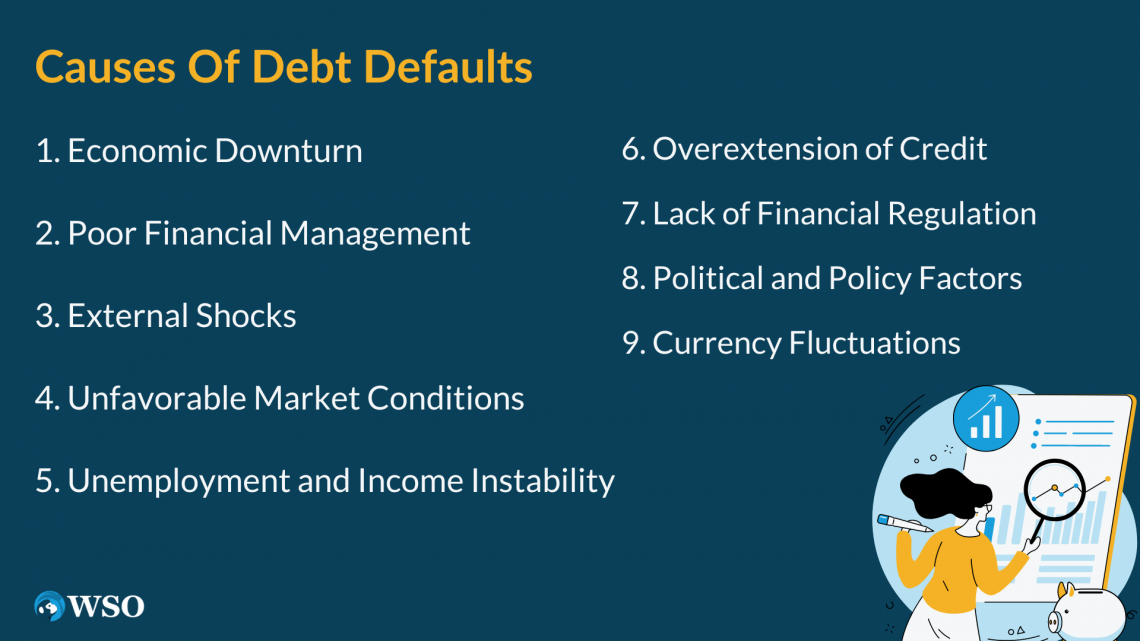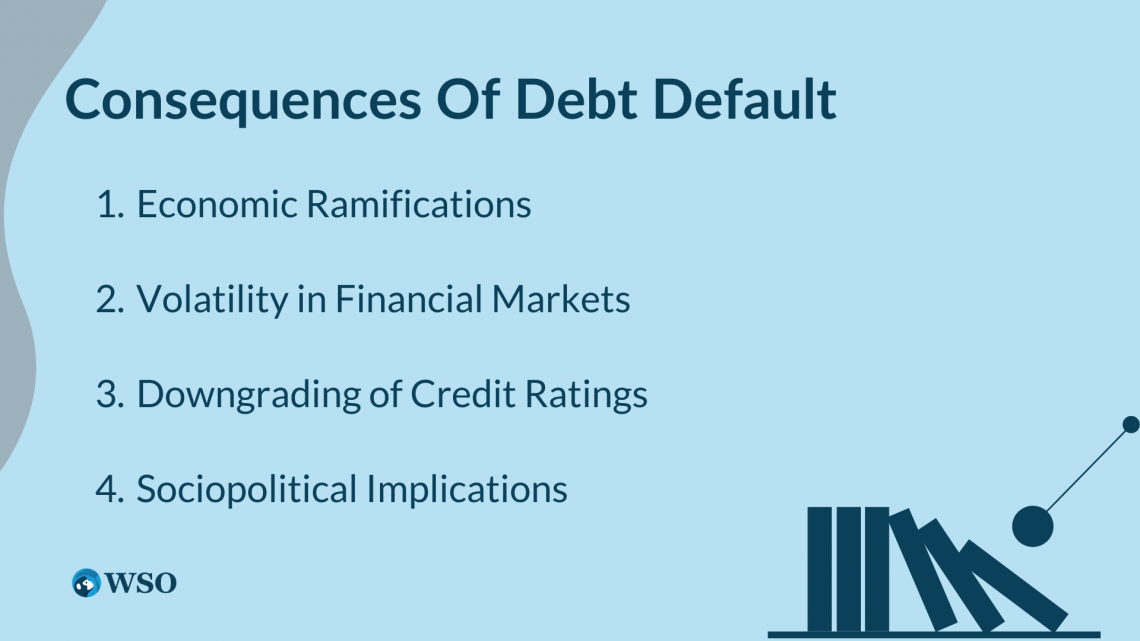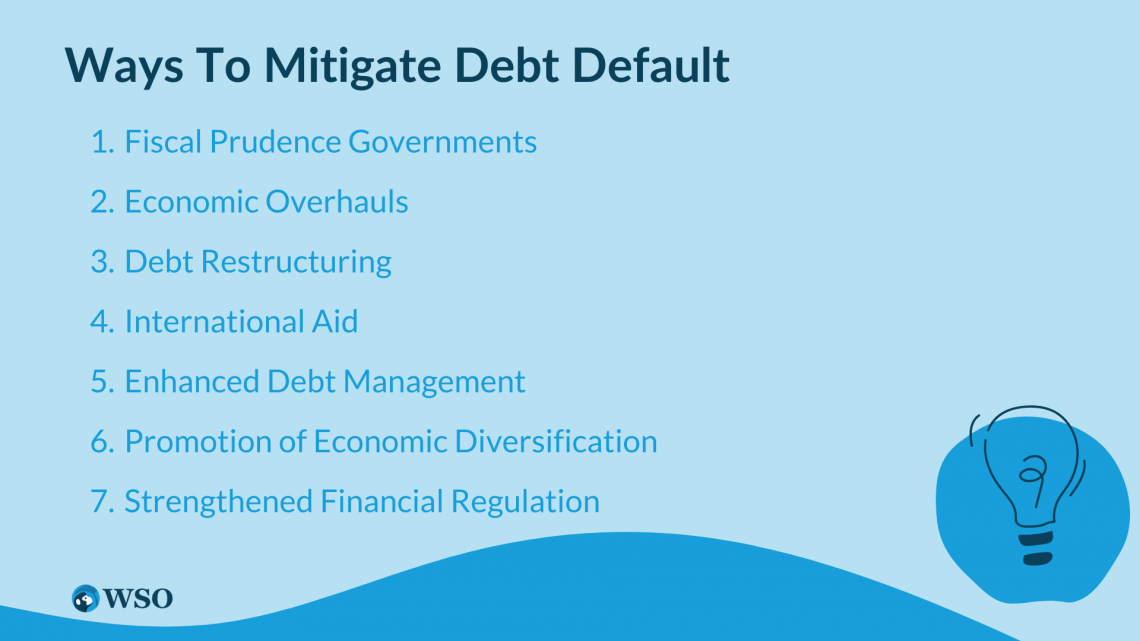Debt Default
It is the failure of a borrower to make required payments on a debt, whether of interest or principal.
What is a Debt Default?
An event of debt default occurs when one or more terms in a loan agreement are violated (or breached) by a borrower.
The matter of debt default presents a complex and consequential phenomenon impacting individuals, businesses, and nations alike. It entails the failure of a borrower to fulfill their financial obligations, including repaying borrowed funds and servicing interest payments.

Debt default poses substantial challenges to economic growth and financial stability. This article endeavors to explore the intricacies surrounding debt default, examining its underlying causes, the ensuing consequences, and potential remedies.
Debt default emerges as a confluence of various factors that strain borrowers' capacity to meet their financial commitments. The origins of a payment default are multifaceted and contingent upon distinct contexts.
Economic downturns and financial instability frequently constitute pivotal catalysts. During times of economic recession or financial crises, businesses grapple with the following:
- Dwindling revenues
- Reduced consumer spending
- Restricted access to credit
These aspects of debt default consequently impede their ability to fulfill debt obligations. Similarly, individuals may face:
- Unemployment
- Diminished incomes
- The overwhelming personal debt burden
In turn, these contribute to heightening the likelihood of default.

Nevertheless, debt default cannot be solely attributed to external economic circumstances. It often stems from imprudent financial management and excessive borrowing practices.
Irresponsible borrowing, exemplified by excessive debt accumulation or overleveraging of assets, imposes a strain on the borrower's ability to make timely repayments.
Lack of financial discipline, failure to develop and adhere to realistic budgets, oversight of cash flow monitoring, and anticipating future financial challenges compound the risks associated with default.
The repercussions of payment default transcend the individual borrower, reverberating across economies and financial systems.

Foremost among these consequences is economic instability. Sovereign payment defaults, for instance, trigger a domino effect, encompassing elevated borrowing costs for governments, waning investor confidence, and currency devaluation.
Consequently, nations encounter diminished access to international financial markets, heightened inflation, and restrained economic growth.
Analogously, corporate or individual payment defaults engender bankruptcies, layoffs, reduced investments, and constricted credit availability, thereby exacerbating economic downturns.
Moreover, payment default engenders financial market volatility, influencing investors and financial institutions alike. The defaulting of bonds or loans engenders significant losses for investors, particularly those holding considerable exposure to the defaulted debt.
Financial institutions entangled with defaulting borrowers may experience compromised asset quality, liquidity predicaments, and even solvency risks, thereby harboring systemic implications.
Key Takeaways
- Debt default is a complex phenomenon that impacts individuals, businesses, and nations, resulting from a failure to meet financial obligations.
- Payment default results from a range of factors, such as economic downturns, subpar financial management, unexpected events, and adverse market conditions
- The consequences of payment default extend beyond the individual borrower, affecting economies and financial systems.
- Mitigating the risk of payment default involves implementing strategies such as fiscal prudence, economic overhauls, debt restructuring, and international aid
- Policymakers, financial institutions, and individuals can leverage these measures to address the underlying causes of debt default, minimize its adverse outcomes, and foster economic stability and growth
Causes Of Debt Defaults
The reasons behind debt defaults are multifaceted and require a thorough exploring the underlying causes. We may better grasp the events that contribute to such scenarios by looking deeper into these aspects.

1. Economic Downturn
During periods of economic recessions or financial crises, borrowers often experience a decline in income and cash flow, posing challenges in meeting their debt obligations.
2. Poor Financial Management
Irresponsible borrowing practices, excessive leveraging, and mismanagement of funds can raise the likelihood of default as borrowers struggle to manage their debt burdens.
3. External Shocks
Unexpected occurrences, such as natural catastrophes, political instability, or worldwide economic downturns, can undermine financial stability and increase borrowers' risk of default.
4. Unfavorable Market Conditions
Movements in interest rates, currency rates, or commodity prices can negatively impact borrowers' capacity to meet their loan repayment commitments.
5. Unemployment and Income Instability
High unemployment rates and income instability significantly impact borrowers' capacity to honor their debts.
Note
Job losses and income reductions make it challenging for individuals to meet their financial commitments, ultimately leading to default.
6. Overextension of Credit
Borrowers who take on excessive debt and become heavily reliant on credit face an increased risk of default. When borrowers become overwhelmed by debt levels they cannot manage, the strain of repayments becomes unsustainable, ultimately resulting in default.
7. Lack of Financial Regulation
Inadequate financial regulation contributes to payment default, allowing for irresponsible lending practices, predatory lending behaviors, and accumulating unsustainable debt levels.
8. Political and Policy Factors
Political instability, uncertainty in policy formulation, and inconsistent regulatory frameworks create an unfavorable environment for borrowers.
Note
Frequent policy changes and uncertain political climates undermine economic stability, amplifying the likelihood of default.
9. Currency Fluctuations
The volatility of exchange rates affects borrowers with debts denominated in foreign currencies. When the value of a borrower's currency depreciates significantly, the burden of debt repayment in terms of the domestic currency intensifies, making it more difficult to fulfill debt obligations.
By comprehending these underlying causes of payment defaults, policymakers, financial institutions, and individuals can devise strategies and implement measures to address these factors and mitigate the risk of default.
Consequences Of Debt Default
A multitude of repercussions can ensue from debt defaults, and it is imperative to understand the potential outcomes. Here, we delve into several key consequences that often accompany instances of debt default.

1. Economic Ramifications
A debt default has the potential to trigger a sequence of events that can impact the entire economy. Sovereign debt default, for instance, may trigger elevated borrowing expenses for the government, dampened investor assurance, and devaluation of the currency.
As a result, accessibility to global financial markets may deteriorate, accompanied by increased prices and slowing economic development.
On the other hand, corporate or individual payment default can lead to insolvency, workforce reductions, diminished investment, and a contraction in credit availability, thereby compounding the existing economic slump.
2. Volatility in Financial Markets
Payment default can inject volatility into the financial markets, impacting investors and financial institutions alike. When bonds or loans default, investors—especially those with substantial exposure to the defaulted debt—face the potential for substantial losses.
Note
Financial institutions that depend largely on defaulting debtors may face a decrease in asset quality, liquidity difficulties, as well as bankruptcy concerns, which can have far-reaching consequences for the system's overall soundness.
3. Downgrading of Credit Ratings
Debt default almost always results in a decrease in a borrower's credit rating. This downgrade signifies a higher likelihood of default, subsequently leading to increased borrowing costs and restricted access to credit markets.
Consequently, borrowers find their ability to secure financing for future projects or meet immediate financial obligations curtailed.
Note
Downgrades can also tarnish the reputation and credibility of the borrower, rendering it more difficult to attract potential investors and forge fruitful business partnerships.
4. Sociopolitical Implications
The ramifications of debt default extend beyond economics and finance, permeating society's social and political fabric. In extreme cases, default can ignite social unrest, trigger political instability, and erode confidence in government institutions.
In reaction to a debt default, authorities may impose restrictions such as cuts in public spending or tax hikes. Unfortunately, such policies can have a negative impact on a household's well-being, increasing existing disparities and intensifying social conflicts.
Ways To Mitigate Debt Default
There exist numerous potential measures to alleviate the likelihood of payment default. These strategies aim to tackle the root causes of default and forestall its adverse outcomes. Below mentioned are some commonly employed approaches.

1. Fiscal Prudence Governments
It can adopt responsible fiscal policies to ensure sustainable debt levels and circumvent default. This entails maintaining a balanced budget, exercising control over public expenditure, and enhancing tax collection mechanisms.
By implementing sound financial practices, governments can diminish the risk of accumulating excessive debt and fortify their capacity to meet financial obligations.
2. Economic Overhauls
Enacting structural reforms can augment economic competitiveness and foster sustainable growth, thereby diminishing the probability of default.
Such reforms may encompass enhancing the business environment, streamlining regulations, investing in infrastructure, and fostering innovation.
Note
By cultivating a favorable economic climate, nations can attract investments, generate revenue, and bolster their ability to service debts.
In cases where borrowers encounter difficulties fulfilling debt obligations, debt restructuring can be a viable solution.
Note
Debt Restructuring involves renegotiating debt terms, such as extending repayment periods, reducing interest rates, or even forgiving a portion of the debt. It can provide temporary respite and enable borrowers to regain financial stability.
4. International Aid
International institutions and other countries can extend financial assistance to countries grappling with the risk of default.
Such assistance can manifest as loans, grants, or technical support. International support can help alleviate immediate financial pressures, stabilize economies, and furnish resources for requisite reforms.
5. Enhanced Debt Management
Implementing effective debt management practices plays a pivotal role in mitigating default risks. This encompasses diligently analyzing debt levels, maintaining transparent and accurate debt records, and deploying risk management strategies.
Note
By actively managing debt, governments can make informed decisions, optimize borrowing costs, and ensure timely debt repayments.
6. Promotion of Economic Diversification
Overdependence on a single sector or revenue source can heighten susceptibility to default. Governments can encourage economic diversification by fostering the development of multiple industries, investing in education and skills training, and attracting foreign direct investment.
Diversification can provide stability, diminish reliance on specific sectors, and create alternative revenue streams.
7. Strengthened Financial Regulation
Stringent financial regulation and supervision are vital in curbing excessive risk-taking and safeguarding the stability of financial institutions.
By enforcing rigorous regulations, monitoring systemic risks, and promoting transparency, regulators can fortify the financial sector's resilience and alleviate the repercussions of default.
Summary
Debt default is driven by factors such as economic downturns, financial instability, and poor financial management. These include recessions, reduced incomes, unemployment, overleveraging, and imprudent financial practices.

Payment default leads to economic instability and financial market volatility. It results in
- Higher borrowing costs
- Reduced investor confidence
- Currency devaluation for sovereign defaults
- Bankruptcies
- Layoffs
- Limited credit availability
Investors and financial institutions face significant losses and potential systemic risks.
Debt defaults can arise due to various factors, including economic downturns, suboptimal financial management, external influences, adverse market conditions, unemployment, and excessive credit reliance.
Note
Insufficient financial regulation, political instability, volatile currency exchange rates, and income instability are additional contributors to the risk of debt default.
Understanding these underlying causes enables the implementation of measures to mitigate default risks and maintain a stable financial environment.
Debt defaults can lead to a chain of economic repercussions, including
- Higher government borrowing costs
- Diminished investor confidence
- Currency devaluation
- Restricted access to global financial markets
- Reduced investment
- Insolvency
- Layoffs
- Contraction in credit availability
These factors contribute to economic slowdowns and hinder overall development.
Note
Debt defaults extend beyond financial domains and impact society and politics. They can trigger social unrest and political instability and erode trust in government institutions.
Credit rating downgrades tarnish borrower reputations, making it harder to attract investors and establish fruitful business partnerships.
Governments can employ responsible fiscal policies, such as balanced budgets and efficient tax collection, to maintain sustainable debt levels and minimize the risk of default.
By implementing structural reforms, practicing effective debt management, and promoting transparency, countries can enhance economic competitiveness, mitigate default risks, and ensure timely debt repayments.









or Want to Sign up with your social account?